×
SparkFun will be closed on Tuesday, December 24th, and Wednesday, December 25th, in observance of the Christmas holiday. Any orders qualifying for same day shipping placed after 2:00 p.m. (MST) on Monday, December 23rd, will be processed on Thursday, December 26th, when we return to regular business hours. Wishing you a safe and happy holiday from all of us at SparkFun!
Please note - we will not be available for Local Pick up orders from December 24th-December 27th. If you place an order for Local Pick-Up we will have those ready on Monday, December 30th.
Robert Bundy is one of our frequent participants in Classic AVC, known for running a pair of inverse pendulum bots dressed up as children.
One of Bob's electronic children
Over the last year or so, I've shared a few emails with Bob. He recently told me about a toy that he had picked up at an antique store in Souix Falls, SD. After some discussion, he agreed to let me take this thing apart (he had already done so) for the entertainment of the masses. Let's check this thing out, 'cuz it's a beauty!
Soak up the glory that is the Greyhound Scenicruiser
Take in that picture above. Sonar guided... audio-magic? Huh. Safe and easy to operate, that's good. I wonder how it works...?
Duck and cover
With a freaking atomic whistle, that's how! Oh... this can only go good places! Alas, the whistle that Bob sent along was not the original but one of the non-atomic variety which, he assures me, makes the Scenicruiser work just fine. And it's gotta be better than putting a radioactive whistle in your mouth.
Maybe this one works on Zero-Point? Whatever. It's magic!
Arright, let's get down to it and crack this thing open.
Bus with top off
In the pic above, the front of the Scenicruiser is to the right and the back is to the left. The motor drive mechanism is the big cylinder just behind the front wheels. A chamber for two D-cells is next to that, and then a relay just ahead of the rear wheels, and that big honking thing at the back? Looks like a microphone of some kind, but let's do a more in-depth walk-around!
The hearing-type thingy
How do I know that's a mic? Well, I know the Scenicruiser is actuated by audible means, so something has to be listening. And that almost looks like 60's-era telephone tech, dumbed down enough to make this cost effective for the time. It's held by a bracket that looks like it's copper, but it's totally not – that's rust. Apparently this bracket is in the circuit, as indicated by the yellow wire soldered to the side.
Back of the mic
Looking at the back side, I don't see... much of anything, really. No magnet, no amplifying circuitry of any kind that I can discern. Empty tube. Piezo?
Yep, that's a relay. Yes, really.
Above you see what is effectively the heart of the system, and it's a seriously janky old 60's era relay, not even in any kind of casing. It's DPDT, and the contacts are wired to the motor assembly in such a way that the voltage polarity is swapped when the relay is energized. The relay is energized on power-up. Also, the giant mic-looking thing is in series with the relay coil, which means that the mic has to have low resistance normally and high resistance to interrupt the relay. Checking resistance across the black and yellow leads that lead to the mic shows about 5 ohms. For what it's worth, there's a cap marked "68K" (either 68pf and a tolerance, or 68nF), and a 1K resistor parallel to the coil.
But let's finish our tour before we get up close and personal with the circuit...
The big oblong thing in the middle is for two D-cells
Expand that picture above and get a close look at the connections to the battery. The wires are soldered onto rivets. What's it look like on the inside?
Inside the battery den
Sparse, that's what. Apparently it was more likely to maintain contact than not...? The bottom hatch (seen above) connects the two batteries in series, and each of the batteries touches a rivet in the top of the chamber to make contact....maybe. I guess you're getting some compression out of the hatch, but if it were me I might have tried a little harder.
Magical moving bits
Above you see the motor drive. When I was a kid (spoiler, I'm 50), these sorts of things were getting weeded out from profitable toy designs, I'm really happy to say. If you've never seen the like, the gist of this thing is that one of those two wheels is driven. When it's turning one way, it'll force that axial carriage around in a circle, resulting in some really erratic driving. But when you reverse the polarity - you always gotta do that, don't you? - a ratchet engages...
Top side of the motor assembly
...and keeps the carriage from spinning around, resulting in that one driven wheel sending the Scenicruiser in a randomly-chosen-yet-singular direction. Now expand that pic, and let me draw your attention to some things. First, the ratchet is that brownish-looking tab in about the 9:45 position of that cylinder. Also look at the white wire and what's going on there. The Scenicruiser's got some skeletons in its closet, looks like, but the wire is continuous, and way less than 30awg. It is left as an exercise for the reader to speculate as to the motives of the perp.
The last bit of interesting anatomy is the power switch.
Now THAT'S a knife
Meh. Fine. I guess you really don't need much for a switch.
The circuit
After some poking around, above is what I came up with for the circuit. Testing shows that the relay is indeed on when there's no whistle, and off when there is. And the whistle is painfully loud, really just the worst. You would never, ever give this to a friend with kids because you'd lose a friend at the very least. One of these in my house would meet with a terrible and unrecoverable accident before its second day. But hey - it's atomic!
The gist of the circuit is simple enough: The "mic" interrupts the current through the relay coil when there's sufficient sound present, and the battery polarity to the motor is swapped between those two states. But that function is like no mic I've ever seen. How in the heck does it do that? There's no amplifying circuit; there's no threshold detection that I can discern...what's going on here?
In the interest of science, I unsoldered one of the leads from the mic and put it across an ohmmeter. The reading bounced around a lot, but it was generally a low number, between 50 and a couple of hundred ohms. When there's sound, the value shoots up to megs-worth of ohms. At close range most sounds will create this condition (so not just that freaking whistle). Near as I can figure, there are two plates in the mic that make a very tenuous contact under normal conditions. When there's sound, the plates separate kinda-sorta, cutting off the current through the coil and tripping the relay. This thing's old, so those plates are probably oxidized and making sketchy contact, which would explain why I see that resistance value jump around so much. Last, they give you a really loud atomic whistle so the system can be actuated over some amount of distance.
Just to prove that it works (and I mean at all), check this out:
You have to watch sorta carefully, but the Scenicruiser's direction does indeed change when I blow the whistle. Not dramatically, but hey, it's an old and tired toy from the 1960's. If you were born then, you might move like that, too, so cut the Scenicruiser some slack. Is there a moral to the story? Maybe that, in spite of all of our new and ever more elaborate tech, you can still get things done with a minimum of junk. That said, I won't be flying any of my drones with an atomic whistle any time soon.

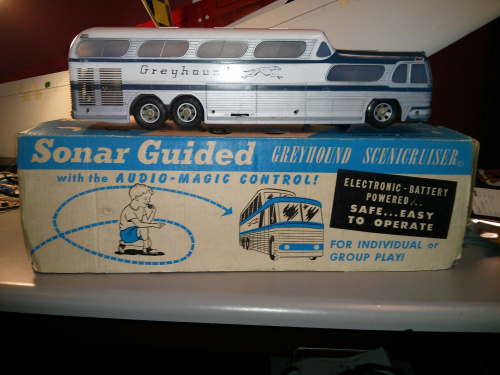

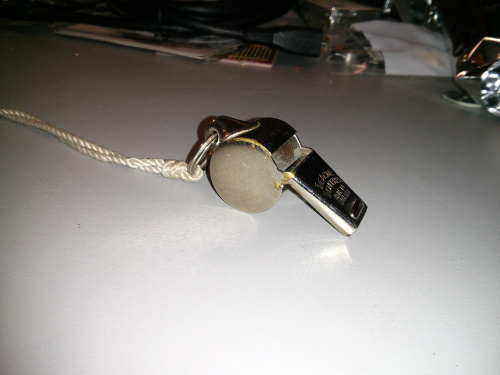
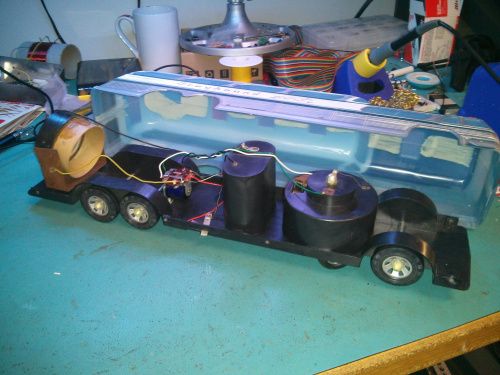
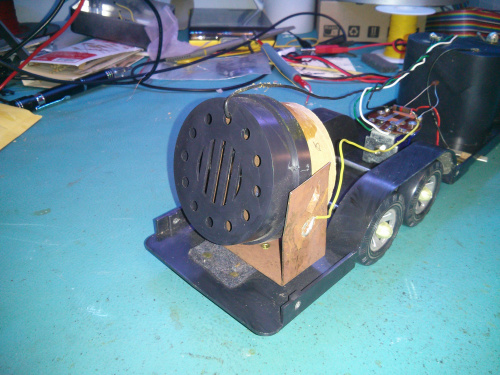
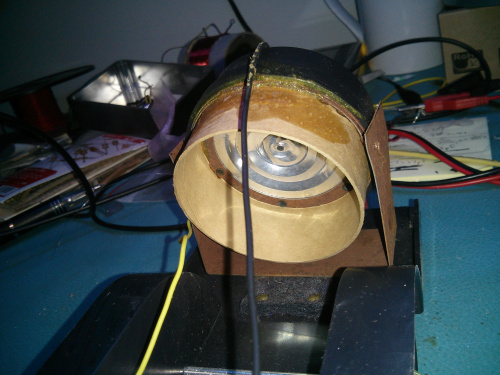
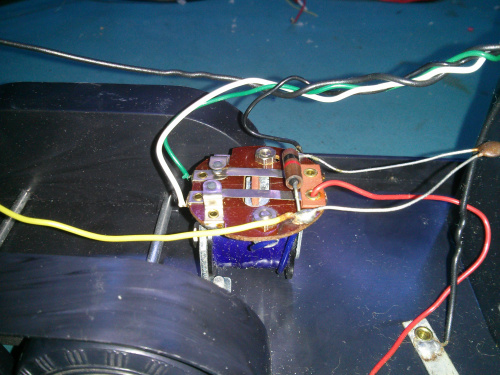
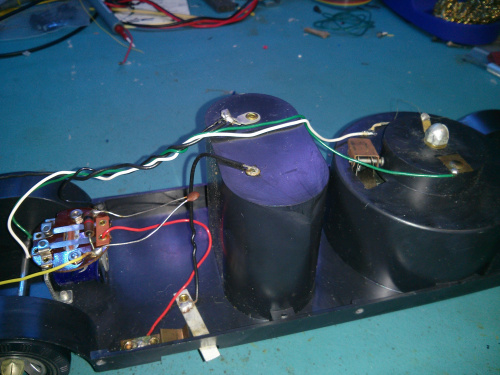
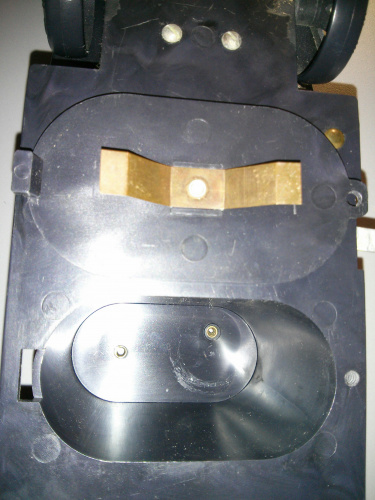

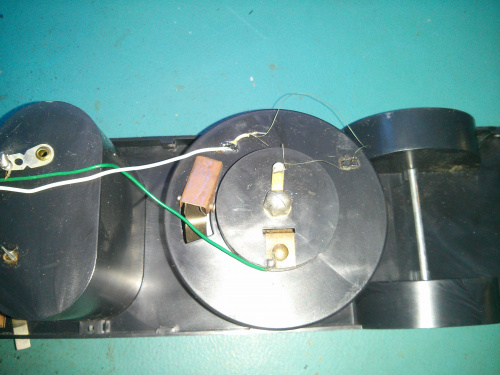
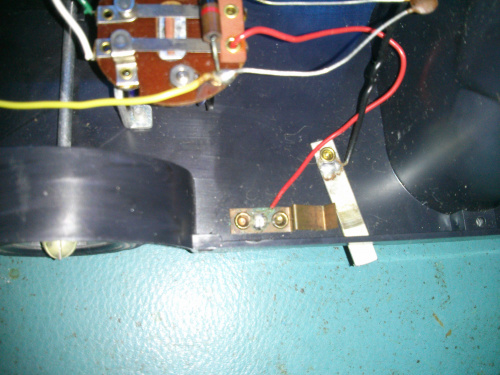
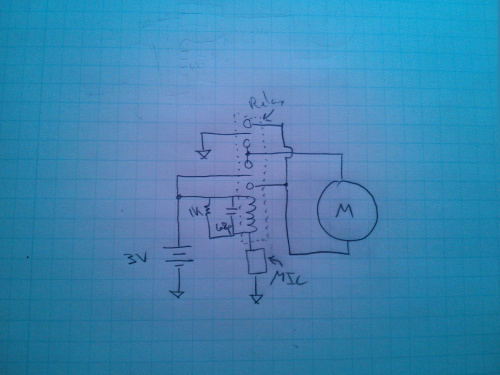






(putting on my "old-fogey" hat) Well, sonny... ;-) I was "doing" electronics a couple of years before you were born, Pete...
I don't recall ever having seen this toy before, even in the "wish book" (annual Sears toy catalog), so I don't think it was very successful. However, I do recall seeing several that were made with about the same level of sophistication, though none that I had access to had any "sonic activation". One of the dominant memories for toys of this era was that they ate batteeries very quickly, and this was back in the days when carbon-zinc was the "state of the art" in battery technology. Many (most?) toys would chew through a set of batteries in a Saturday's play, even with time out to watch Saturday morning cartoons. (Your hypothetical friend would be thankful if you didn't give the kids any spare batteries, so that it would quit very quickly!)
I also recall TVs of the time that had a two button remote control. The remote did NOT have a battery or any electronics in it: when you pushed one of the buttons, it would shove back and then release a "clapper" to strike against a small metal rod (the two rods were of different sizes, thus producing different "tones"). The "tones" produced were "ultrasonic", well above human hearing. The TV set had an ultrasonic receiver, and would respond to the button pushes. One would cycle the volume through about 4 or 5 steps, plus "off" (and then "on"). The other would cause the tuner to switch to the next channel. (I think there was a way to select which channels were "active", as most areas only got a few -- where I lived, 4, and this back when most TVs only received channels 2 through 13.) I never got the opportunity to take apart a TV that had this feature, but did have the chance to take apart the remote for one. (I was bedridden in the hospital at the time, and likely used the knife from the food tray as a screwdriver -- "tamper resistant" screws were very uncommon in those days.)
One other comment: Back in the days when the Greyhound toy was probably made, I'd guess that the typical AM-only transistor radio probably cost nearly twice what the toy did. Plus, this was before the "9-volt rectangular battery" was ubiquitous, and you'd have to hunt a lot to find a replacement battery for the radio (not to mention that it was expensive). I recall being in 3rd grade, and out on the playground for recess -- one of the "rich kids" had a radio (and a functioning battery) and had it turned on, when the news came through that President Kennedy had been shot. I was playing, maybe 20 feet away from the radio, with a Matchbox type car.
773! I remember TV remotes like you describe, the ultrasonic ones. You could jingle your keys in front of the TV and it would change channels. One of the technological marvels that lead me to this ultimate career...